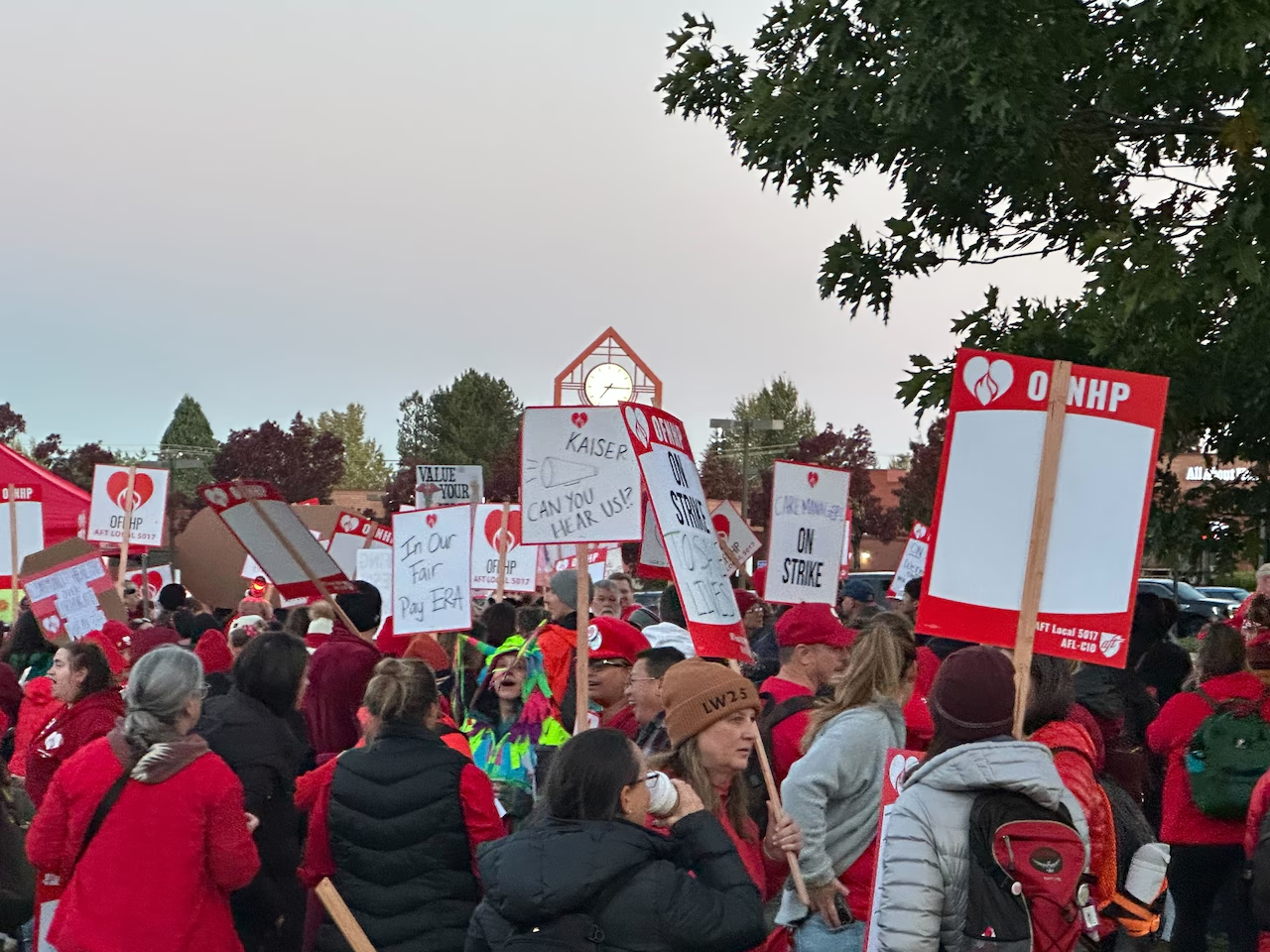PORTLAND, Ore. — In a dramatic escalation of nationwide labor unrest in the health care industry, about 4,000 Kaiser Permanente frontline workers in Oregon and southwest Washington walked off the job early Tuesday morning. The strike is part of a coordinated, multi-state walkout involving more than 43,000 Kaiser employees across California and Hawaii.
The walkout — which began at 7 a.m. Tuesday and is set to end at 7 a.m. Sunday — has disrupted operations at Kaiser’s Sunnyside Medical Center in Clackamas, Westside Medical Center in Hillsboro, and dozens of clinics and specialty care centers along the Interstate 5 corridor, from Longview, Washington, to Eugene, Oregon.
Workers Demand Safe Staffing and Fair Wages
The striking workers are represented by the Oregon Federation of Nurses & Health Professionals (OFNHP), which includes a broad spectrum of clinicians: nurses, nurse practitioners, midwives, physician assistants, physical and occupational therapists, genetic counselors, dietitians, and speech-language pathologists.
Also Read
Union leaders say the strike follows six months of stalled contract negotiations with Kaiser. The previous contract expired on September 30, and talks have failed to resolve disputes over wages, staffing levels, and worker input in patient care decisions.
“We’ve been working hard with so little resources since the pandemic,” said Robin Esperanza, a nurse case manager at Kaiser Sunnyside’s emergency department. “We’ve been expected to do even more with less and less.”
Esperanza, who left her shift early Tuesday to join the picket line, said the strike is about ensuring safe patient care. “When we’re short-staffed, it’s not just stressful for us — it’s dangerous for our patients.”
Outside Kaiser Sunnyside, hundreds of striking workers dressed in red — the union’s color — waved signs reading “Safe Staffing Saves Lives” and “Patients Before Profits.” Some carried instruments and costumes, creating a festive but determined atmosphere as passing cars honked in support.
Kaiser’s Response
Kaiser Permanente, one of the nation’s largest nonprofit health care providers, said it has contingency plans in place to ensure continuity of care. Its hospitals, pharmacies, and medical offices remain open, though some appointments and elective procedures may be rescheduled or moved online.
The company’s Northwest division serves more than 600,000 patients across Oregon and southwest Washington.
In a statement, Kaiser officials called the strike “unnecessary and disruptive,” arguing that the organization has made a fair offer. Kaiser says union members already earn about 16% more than comparable workers at other health systems. Its most recent proposal includes a 21.5% wage increase over four years and expanded health and retirement benefits.
Union negotiators, however, are seeking a 25% wage increase and guarantees on safe staffing ratios. Kaiser contends that meeting those demands would add hundreds of millions to its $6.3 billion annual payroll and could drive up costs for patients and insurance plan members.
To minimize disruptions, Kaiser says it plans to onboard 7,600 temporary health care professionals during the strikes in Oregon, California, and Hawaii.
Eroding Partnership and Growing Frustration
Union president Sarina Roher said the strike represents a turning point in what was once considered a model labor-management partnership. For decades, Kaiser and its unions worked collaboratively to avoid major strikes. That cooperative spirit, Roher said, has unraveled since the COVID-19 pandemic.
“Kaiser’s foundation and mission were built on partnership with workers,” she said. “We have our doors open to restore that partnership, but right now, we’re being left out of decisions that affect our patients and our professions.”
April Milan, a physical therapist at Sunnyside for 12 years, echoed that frustration. She said clinicians want more than higher pay — they want a voice in how patient care is structured.
“We know our professions. We know the time it takes to provide quality care,” Milan said. “If we can’t have it written into our contract that we have input in patient care decisions, it’s concerning. Who will make those calls — administrators or those of us on the front lines?”
A Broader Labor Movement in Health Care
This week’s strike is the latest in a wave of health care labor actions across Oregon and the country. Earlier this year, nearly 5,000 Providence Health workers held a 46-day strike, and nurses at Legacy Mount Hood Medical Center narrowly avoided one after reaching a last-minute deal.
Labor experts say the Kaiser strike underscores growing frustration among health care workers facing burnout, staffing shortages, and stagnant wages in the post-pandemic era.
While the five-day strike is scheduled to end Sunday, union officials warn that more walkouts could follow if negotiations fail to make progress.
As Esperanza stood on the picket line Tuesday morning, she said her message was simple: “We’re not just fighting for better contracts. We’re fighting for our patients — and for the future of health care.”












